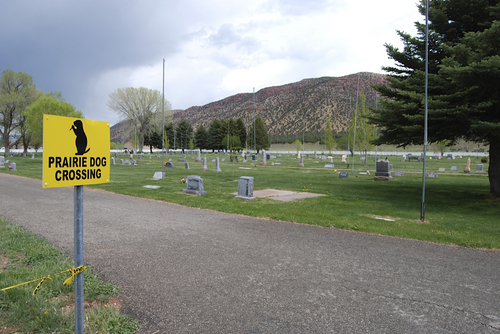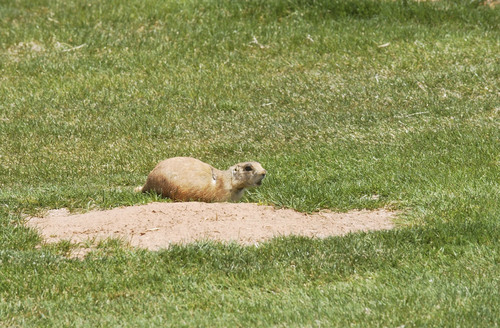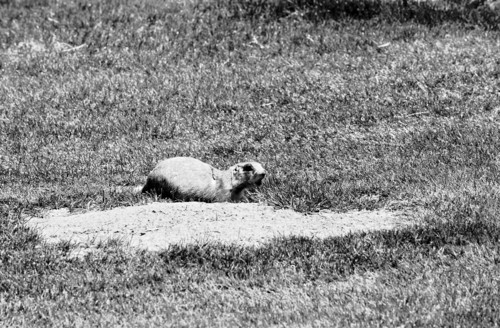This is an archived article that was published on sltrib.com in 2014, and information in the article may be outdated. It is provided only for personal research purposes and may not be reprinted.
Parts of Iron County seem to teem with a rare, but pesky rodent that has been under federal protection since 1973.
The Utah prairie dog burrows into cemeteries and eats funeral flowers, damages airport runways and perforates fields with holes that wreck agricultural equipment, local officials say.
And worse, federal protection measures for the prairie dog and other listed species undermine human communities, while environmental groups enrich themselves suing federal agencies, according to testimony in Congress on Tuesday supporting several bills to "improve" the 1973 Endangered Species Act.
"That species inhibits the use of private property to the degree that we've had tens if not hundreds of millions of dollars of economic impact, while we have exponential growth in the population of prairie dogs," Iron County Commissioner Dave Miller told the House Natural Resources Committee.
The Utah prairie dog, whose burrowing also provides important ecological services, remains on the threatened species list because most inhabit private and other non-federal lands, Iron County officials say. Miller spoke in support of Rep. Chris Stewart's bill which would require the U.S. Fish and Wildlife Service (FWS) to count all individual animals toward a listed species' recovery, not just those in protected areas. The legislation might speed the prairie dog's exit from protected status, but critics say it also could grease the animal's slide into extinction.
"I don't know how anyone could oppose this. It's such common sense and hardly controversial," said Stewart, R-Utah. "If we list a species, we would want to know how many there are. None of us wants to see a species go extinct."
Fish and Wildlife already counts individual animals for estimating population size, but sometimes the agency won't credit them all as contributing to a secure population, according to Gary Frazer, FWS' assistant director for ecological services. He expressed a willingness to work with lawmakers to meet Stewart's goals if it can be done without compromising the process for determining species' status.
Wildlife advocates were not nearly so charitable, finding much to oppose in Stewart's bill, as well as others heard Tuesday that seek to reverse listing decisions; give states greater authority over habitat management; make legal settlements over listing decisions more transparent and bar awards of attorney fees to groups that file such suits.
Officials with Defenders of Wildlife, one of the groups accused of profiting off ESA litigation, said these bills would "obstruct recovery efforts and act as if the extinction crisis is over." Conservation director Ya-Wei Li singled out Stewart's bill as "poorly written, rife with ambiguities, and biologically indefensible."
He argued the bill's mandates would be impossible to meet because many listed species are difficult to find and costly to count, particularly if the work requires access to private land.
"Individuals on unprotected lands must be counted [under the Stewart bill], even in areas destined to be bulldozed in the future," Li said. "This requirement would be disastrous for species like the Utah prairie dog, with less than 4 percent of individuals on protected lands and much of the remaining populations in areas facing growing pressure from agricultural and urban development."
Meanwhile, an Iron County group called People for the Ethical Treatment of Property Owners, including the town of Cedar City, has sued the FWS over prairie dog damage. U.S. District Judge Dee Benson on Thursday hears the group's request to invalidate federal regulations protecting prairie dogs, which members say devalue their land.
Federal agencies administer most of the land in seven south-central Utah counties harboring prairie dog habitat. Yet the dogs appear to proliferate mostly on unprotected private lands in Iron County, where their burrowing is not only a nuisance, but their presence complicates development proposals.
Costly efforts are underway to relocate prairie dogs from private land to the national forest in Garfield County, with mixed results.
Under the feds' recovery plan, the species won't be delisted until its adult population exceeds 2,000 on protected lands in each of three prairie dog recovery zones for five consecutive years. Of the 6,300 adults FWS counted last year, only about 1,600 were on protected lands.
FWS hopes to fund the acquisition of about 800 acres of state trust land southwest of Loa to expand protected holdings in the Awapa Plateau recovery unit. Opposition from Wayne County officials may scuttle the deal, which also would put up to $1 million into the state's permanent school fund.







